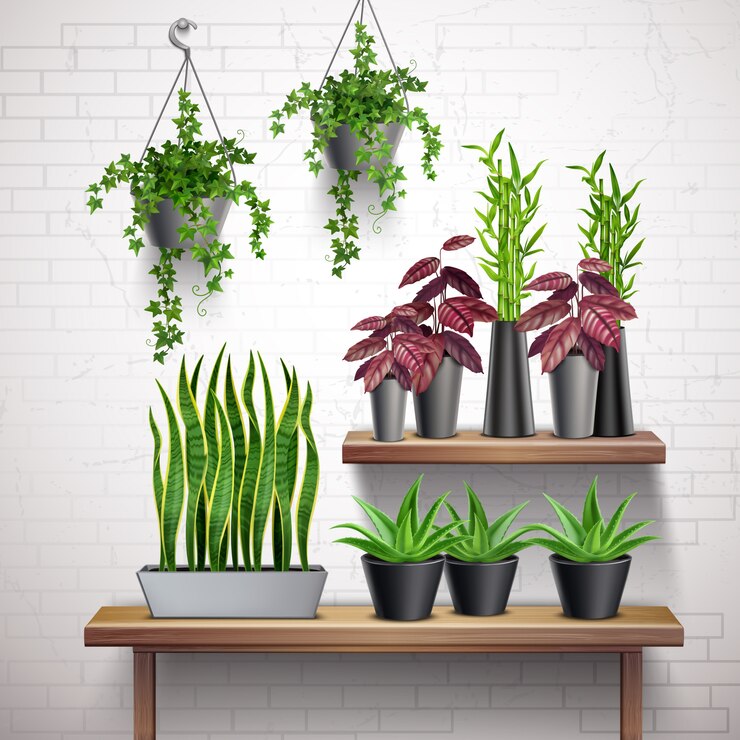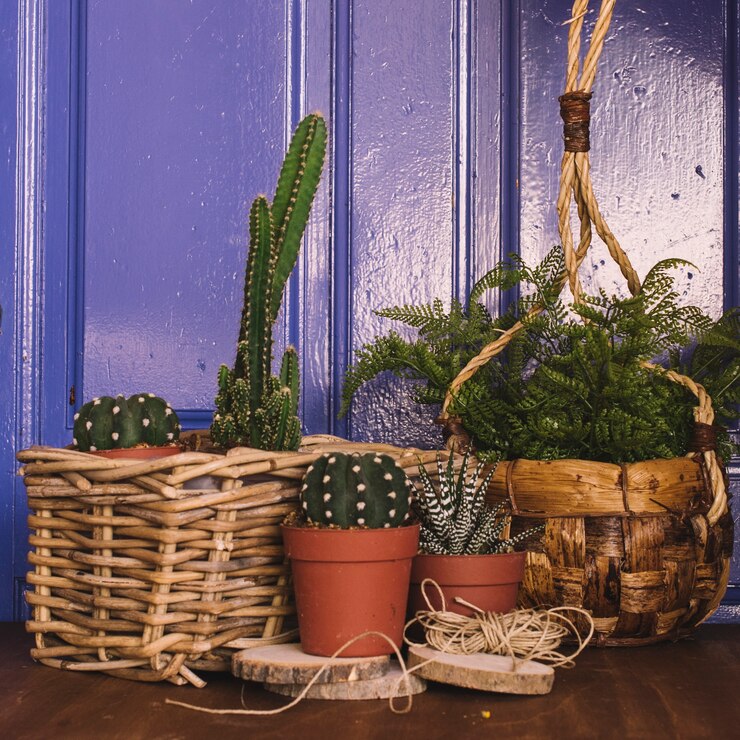Craving the serenity and beauty of a flourishing garden but limited by square footage? Fear not, urban dwellers and balcony enthusiasts! Vertical gardens offer a stylish and space-saving solution, transforming walls into vibrant ecosystems. This article equips you with the latest gardening ideas and designs to create a thriving vertical haven in your compact space.
Planning Your Vertical Oasis
Before diving headfirst into planter purchases, some crucial planning is necessary. Here’s what to consider:
- Sunlight Exposure: Understanding the amount of natural light your chosen wall receives is paramount. Low-light areas favor ferns, bromeliads, and certain ivy varieties. For sun-drenched walls, consider succulents, herbs, and flowering varieties like trailing verbena.
- Weight Capacity: Ensure your chosen wall structure can support the weight of a fully loaded vertical garden, especially for heavier materials like clay pots. Opt for lightweight options like felt pockets or recycled plastic planters for flimsier walls.
- Watering Needs: Vertical gardens require careful watering strategies. Self-watering planters or integrated irrigation systems can be lifesavers for busy gardeners. Grouping plants with similar water needs simplifies the process.
Creative Container Concepts
The beauty of vertical gardens lies in their versatility. Here are some trending ideas to inspire you:
- Living Walls: These prefabricated panels, often modular, house plants within a felt or fabric backing. Living walls offer a sleek, modern aesthetic and simplified maintenance.
- Pocket Planters: Fabric pockets with reinforced backs can be directly attached to walls. They’re perfect for herbs, small succulents, and trailing vines.
- Upcycled Chic: Repurpose everyday items! Turn old rain gutters, wooden crates, or even mismatched teacups into charming vertical planters.
- Shoe Organizer Revamp: Don’t toss that old shoe organizer! Lined with plastic sheeting, it transforms into a vertical herb haven on your balcony.
Planting for Success
Once you’ve chosen your design, it’s time to select your plant companions. Here are some key considerations:
- Plant Size and Growth Habit: Opt for compact varieties with cascading or trailing growth patterns. Consider the mature size of your chosen plants to avoid overcrowding.
- Pollination Partners: If you plan on growing vegetables or flowering plants, ensure they are pollinator-friendly to attract helpful insects like bees and butterflies, even in a small space.
- Color and Texture Play: Mix and match foliage textures and colors for a visually stunning display. Experiment with variegated leaves, bright blooms, and trailing vines for a dynamic effect.
Vertical Gardening: Beyond the Basics
Vertical gardens can be more than just an aesthetic enhancement. Here are some advanced techniques to elevate your creation:
- Living Art Panels: Create a “living portrait” by strategically planting foliage of varying heights and textures to form a recognizable image.
- Herb Towers: Stack vertically connected planters to create a dedicated herb tower, perfect for fresh culinary delights at your fingertips.
- Integrated Lighting: For low-light areas, consider incorporating LED grow lights to supplement natural light and ensure healthy plant growth.
Embrace the Vertical Revolution
With a little planning and creativity, vertical gardens can transform your limited space into a flourishing sanctuary. So, unleash your inner designer, embrace the vertical revolution, and watch your walls blossom into a vibrant green haven.
Indoor Gardening:
- Sunlight Exposure:Understanding the amount of natural light your chosen wall receives is paramount. Low-light areas favor ferns, bromeliads, and certain ivy varieties. For sun-drenched walls, consider succulents, herbs, and flowering varieties like trailing verbena.Opens in a new windowchevron_rightwww.amazon.com Indoor vertical garden with succulents
- Weight Capacity: Ensure your chosen wall structure can support the weight of a fully loaded vertical garden, especially for heavier materials like clay pots. Opt for lightweight options like felt pockets or recycled plastic planters for flimsier walls.
- Watering Needs: Vertical gardens require careful watering strategies. Self-watering planters or integrated irrigation systems can be lifesavers for busy gardeners. Grouping plants with similar water needs simplifies the process.
Creative Container Concepts
The beauty of vertical gardens lies in their versatility. Here are some trending ideas to inspire you:
- Living Walls: These prefabricated panels, often modular, house plants within a felt or fabric backing. Living walls offer a sleek, modern aesthetic and simplified maintenance Indoor living wall vertical garden

- Pocket Planters: Fabric pockets with reinforced backs can be directly attached to walls. They’re perfect for herbs, small succulents, and trailing vinesIndoor pocket planter vertical garden

- Upcycled Chic: Repurpose everyday items! Turn old rain gutters, wooden crates, or even mismatched teacups into charming vertical planters.

Benefits of Indoor Gardening:
- Improved Air Quality: Plants act as natural air filters, absorbing pollutants and toxins like benzene and formaldehyde, common in household cleaning products and furniture. This can lead to better breathing and fewer headaches.
- Reduced Stress and Improved Mood: Studies have shown that caring for plants can be a calming and therapeutic activity. The presence of greenery can lower stress hormones and promote feelings of relaxation.
- Increased Humidity: Plants release moisture into the air, which can help combat dryness, especially during winter months. This can improve respiratory health and alleviate dry skin.
- Aesthetics and Ambiance: Lush greenery adds vibrancy and life to any space. Indoor gardens can create a more inviting and relaxing atmosphere in your home.
- Fresh Produce: Growing herbs or even small vegetables indoors allows you to enjoy fresh, organic ingredients right at your fingertips.
Maintaining Your Indoor Oasis:
- Light: Understanding your plant’s light needs is crucial. Some plants thrive in bright, indirect light, while others do well in low-light conditions. Research your chosen plants to ensure they get the right amount of light.
- Watering: Overwatering is a common mistake with indoor plants. Feel the soil regularly; water only when the top inch is dry. The frequency will depend on the plant, pot size, and light conditions.
- Soil: Use a well-draining potting mix specifically formulated for indoor plants. This allows for proper aeration and prevents waterlogging.
- Fertilizing: Most houseplants don’t need frequent fertilizing. A balanced, water-soluble fertilizer applied once a month during the growing season (usually spring and summer) is sufficient.
- Pests and Diseases: Indoor plants are generally less susceptible to pests than outdoor plants. However, keep an eye out for common problems like mealybugs or spider mites. Insecticidal soap or neem oil can be effective solutions.
Frequently Asked Questions:
A: Indoor vertical gardens offer a wealth of benefits, including improved air quality, reduced stress, increased humidity, a more aesthetically pleasing space, and even the potential for fresh herbs or vegetables!
A: Absolutely! Many low-light tolerant plants thrive in vertical gardens. Consider supplementing natural light with LED grow lights.
A: Low-light tolerant plants like ferns and bromeliads are ideal for areas with minimal sunlight. For brighter spaces, succulents, herbs, and trailing vines like verbena are great choices.
A: The options are endless! Popular choices include living walls, fabric pocket planters, upcycled items like rain gutters or teacups, and even repurposed shoe organizers.
Suggested Articles:
Bamboo House designs: Perfect way to Relax
Top Rangoli Designs for 2024: Try these Easy and Simple Rangoli designs









































